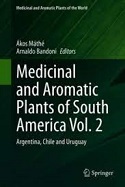Passiflora caerulea L.
Dublin Core
Título
Tema
Abstract
Passiflora caerulea L. (Passifloraceae) (“mburucuyá”, “maracujá-laranja”), a widely distributed species in South America, has been traditionally considered as a medicinal, ornamental, and edible plant. Its fruits, besides being well
appreciated for their flavor and sweetness, have valuable nutritional properties. The ethnopharmacological use as anxiolytic, antistress and sedative of the non-reproductive
aerial parts (leaves and tendrils) from P. caerulea is the main reason for its commercialization as an infusion herb. In general, its preparations are rich in flavonoids (chrysin and C-glycosides such as vitexin, isovitexin, orientin, isoorientin, and vicenin-2, among others), which were confirmed as responsible for the anxiolytic effect. The Argentine Pharmacopeia includes a monograph on P. caerulea, while other Pharmacopeias (Brazilian, European, and British) consider it as a potential
adulterant of P. incarnata and P. edulis. Harmala alkaloids from P. caerulea might also contribute to the anxiolytic effect, but no preclinical assays have been conducted to confirm it. Pharmacological research confirmed other bioactivities associated with the aerial parts of P. caerulea, such as antimicrobial, gastroprotective, analgesic, and anticonvulsant. Even though, no systematic toxicological assessments have been conducted in order to evaluate the safety in the consumption, especially regarding the presence of cyanogenic glycosides both in the vegetal drug and the unripe fruits.
Autor
Fuente
Editor
Fecha
Derechos
Información sobre Derechos de Autor
(Por favor lea este aviso antes de abrir los documentos u objetos)
La legislación uruguaya protege el derecho de autor sobre toda creación literaria, científica o artística, tanto en lo que tiene que ver con sus derechos morales, como en lo referente a los derechos patrimoniales con sujeción a lo establecido por el derecho común y las siguientes leyes (LEY 9.739 DE 17 DE DICIEMBRE DE 1937 SOBRE PROPIEDAD LITERARIA Y ARTISTICA CON LAS MODIFICACIONES INTRODUCIDAS POR LA LEY DE DERECHO DE AUTOR Y DERECHOS CONEXOS No. 17.616 DE 10 DE ENERO DE 2003, LEY 17.805 DE 26 DE AGOSTO DE 2004, LEY 18.046 DE 24 DE OCTUBRE DE 2006 LEY 18.046 DE 24 DE OCTUBRE DE 2006)
ADVERTENCIA - La consulta de este documento queda condicionada a la aceptación de las siguientes condiciones de uso: Este documento es únicamente para usos privados enmarcados en actividades de investigación y docencia. No se autoriza su reproducción con fines de lucro. Esta reserva de derechos afecta tanto los datos del documento como a sus contenidos. En la utilización o cita de partes debe indicarse el nombre de la persona autora.
Formato
Idioma
Tipo
Identificador
Document Item Type Metadata
Original Format
- Fecha de agregación
- August 2, 2021
- Colección
- Bibliografía Nacional Química
- Tipo de Elemento
- Document
- Etiquetas
- Anticonvulsivos, Flavonoides, Maracuyá
- Citación
- Minteguiaga,Manuel, “Passiflora caerulea L.,” RIQUIM - Repositorio Institucional de la Facultad de Química - UdelaR, accessed July 26, 2024, https://riquim.fq.edu.uy/items/show/6302.
- Archivos

